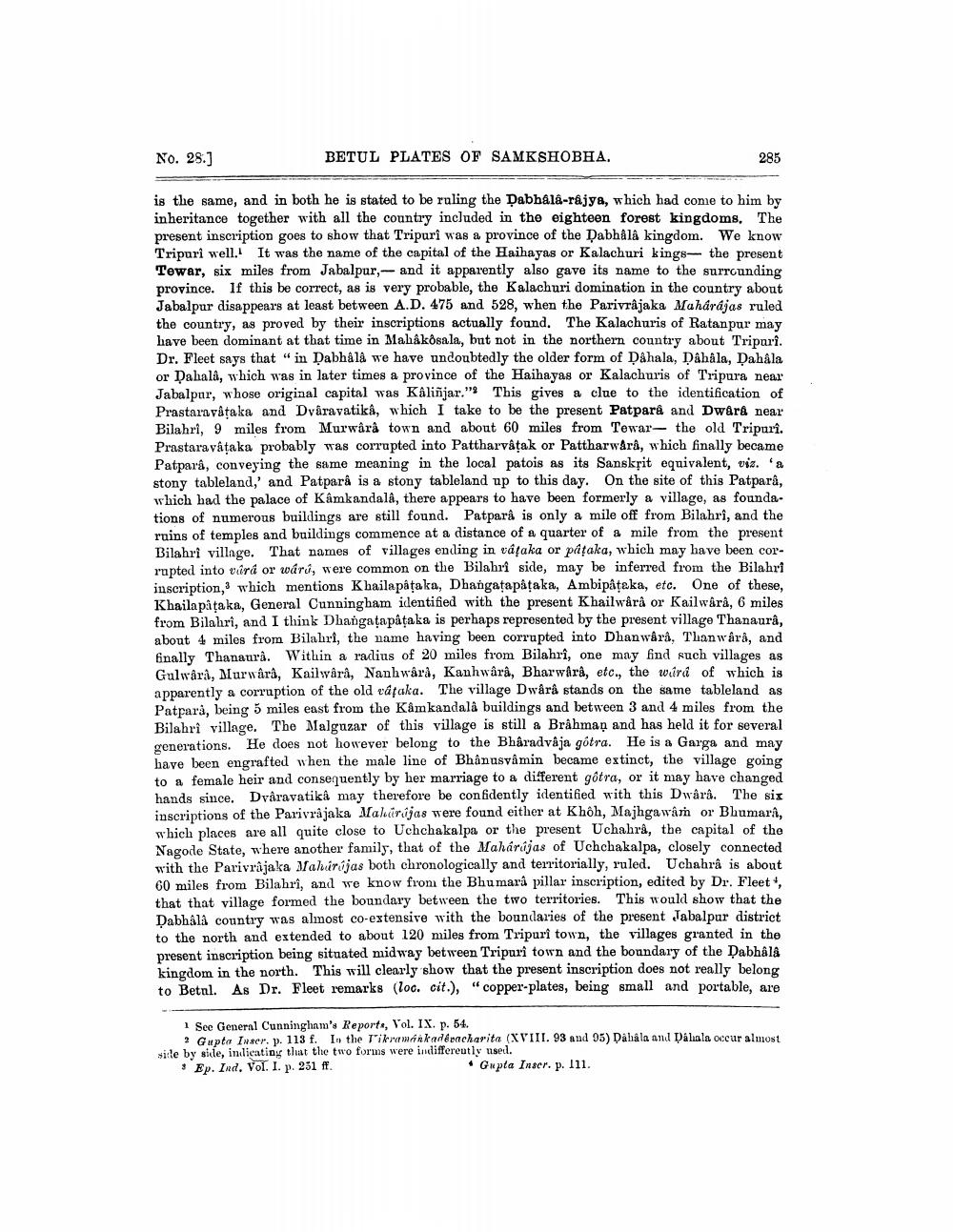________________
No. 28.)
BETUL PLATES OF SAMKSHOBHA.
285
is the same, and in both he is stated to be ruling the Dabhald-rajya, which had come to him by inheritance together with all the country included in the eighteen forest kingdoms. The present inscription goes to show that Tripuri was a province of the Dabhålâ kingdom. We know Tripurî well. It was the name of the capital of the Haihayas or Kalachuri kings, the present Tewar, six miles from Jabalpur,- and it apparently also gave its name to the surrounding province. If this be correct, as is very probable, the Kalachuri domination in the country about Jabalpur disappears at least between A.D. 475 and 528, when the Parivrâjaka Maharajas ruled the country, as proved by their inscriptions actually found. The Kalachuris of Ratanpur may have been dominant at that time in Mahákösala, but not in the northern country about Tripari. Dr. Fleet says that " in Dabhålå we have undoubtedly the older form of Dåhala, Dåhåla, Dahåla or Dahala, which was in later times a province of the Haihayas or Kalachuris of Tripura near Jabalpur, whose original capital was Kaliñjar." This gives a clue to the identification of Prastara våtaka and Dväravatika, which I take to be the present Patparâ and Dwårå near Bilahri, 9 miles from Murwarà town and about 60 miles from Tewar- the old Tripuri. Prastaraváțaka probably was corrupted into Pattharvatak or Pattharwårå, which finally became Patpará, conveying the same meaning in the local patois as its Sanskrit equivalent, viz. a stony tableland,' and Patparê is a stony tableland up to this day. On the site of this Patpara, which had the palace of Kâmkandalâ, there appears to have been formerly a village, as foundations of numerous buildings are still found. Patparà is only a mile off from Bilahri, and the ruins of temples and buildings commence at a distance of a quarter of a mile from the present Bilahri village. That names of villages ending in vafaka or pataka, which may have been corrupted into virá or waru, were common on the Bilahri side, may be inferred from the Bilahri inscription, which mentions Khailapataka, Dhangatapataka, Ambipataka, etc. One of these, Khailapata ka, General Cunningham identified with the present Khailwårå or Kailwara, 6 miles from Bilahri, and I think Dhangatapataka is perhaps represented by the present village Thanaurâ, about 4 miles from Bilahri, the name having been corrupted into Dhanwara, Thanwårå, and finally Thanaura. Within a radius of 20 miles from Bilahri, one may find such villages as Gulwara, Murward, Kailwara, Nanhwårå, Kanhwårå, Bharwara, etc., the wire of which is apparently a corruption of the old vafaka. The village Dwårå stands on the same tableland as Patpará, being 5 miles east from the Kámkandala buildings and between 3 and 4 miles from the Bilahri village. The Malguzar of this village is still a Brahman and has held it for several generations. He does not however belong to the Bharadvaja gótra. He is a Garga and may have been engrafted when the male line of Bhânusvamin became extinct, the village going to a female heir and consequently by her marriage to a different gôtra, or it may have changed hands since. Dvâravatika may therefore be confidently identified with this Dwars. The six inscriptions of the Parivrajaka Maharijas were found either at Khôh, Majhga war or Bhumara, which places are all quite close to Uchchakalpa or the present Uchahra, the capital of the Nagode State, where another family, that of the Mahárújas of Uchchakalpa, closely connected with the Parivrâjaka Mahirajas both chronologically and territorially, ruled. Uchahra is about 60 miles from Bilahrî, and we know from the Bhumara pillar inscription, edited by Dr. Fleet, that that village formed the boundary between the two territories. This would show that the Dabhála country was almost co-extensive with the boundaries of the present Jabalpur district to the north and extended to about 120 miles from Tripuri town, the villages granted in the present inscription being situated midway between Tripuri town and the boundary of the Dabhala kingdom in the north. This will clearly show that the present inscription does not really belong to Betul. As Dr. Fleet remarks (loc. cit.),"copper-plates, being small and portable, are
1 See General Cunningham's Reports, Vol. IX. p. 54.
Gupta Inser. p. 113 f. In the t'i krwan kadacharita (XVIII. 93 and 95) Dáhala and Dáliala occur almost ile by siile, indicating that the two forms were indiffereutly useil. 9 Ep. Ind. Vol. I. p. 231 ff.
• Gupta Inscr. p. 111.




